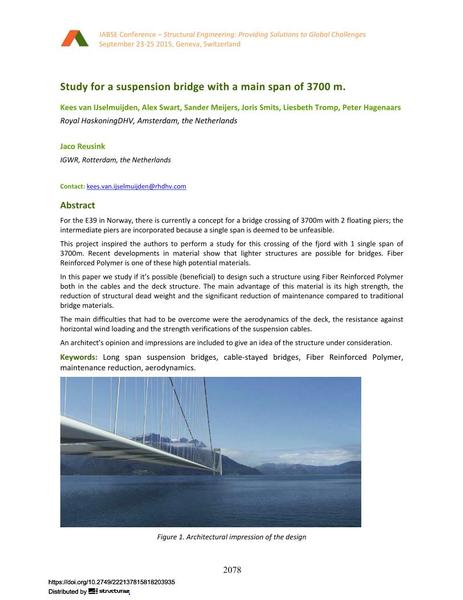Study for a suspension bridge with a main span of 3700 m.

|
|
|||||||||||
Bibliografische Angaben
| Autor(en): |
Kees Ijselmuijden
(Royal HaskoningDHV, Amsterdam, the Netherlands)
Jaco Reusink (IGWR, Rotterdam, the Netherlands) Liesbeth Tromp (Royal HaskoningDHV, Amsterdam, the Netherlands) Sander Meijers (Royal HaskoningDHV, Amsterdam, the Netherlands) Peter Hagenaars (Royal HaskoningDHV, Amsterdam, the Netherlands) Alex Swart (Royal HaskoningDHV, Amsterdam, the Netherlands) Joris Smits (Royal HaskoningDHV, Amsterdam, the Netherlands) |
||||
|---|---|---|---|---|---|
| Medium: | Tagungsbeitrag | ||||
| Sprache(n): | Englisch | ||||
| Tagung: | IABSE Conference: Structural Engineering: Providing Solutions to Global Challenges, Geneva, Switzerland, September 2015 | ||||
| Veröffentlicht in: | IABSE Conference Geneva 2015 | ||||
|
|||||
| Seite(n): | 2078-2085 | ||||
| Anzahl der Seiten (im PDF): | 8 | ||||
| Jahr: | 2015 | ||||
| DOI: | 10.2749/222137815818203935 | ||||
| Abstrakt: |
For the E39 in Norway, there is currently a concept for a bridge crossing of 3700m with 2 floating piers; the intermediate piers are incorporated because a single span is deemed to be unfeasible. This project inspired the authors to perform a study for this crossing of the fjord with 1 single span of 3700m. Recent developments in material show that lighter structures are possible for bridges. Fiber Reinforced Polymer is one of these high potential materials. In this paper we study if it’s possible (beneficial) to design such a structure using Fiber Reinforced Polymer both in the cables and the deck structure. The main advantage of this material is its high strength, the reduction of structural dead weight and the significant reduction of maintenance compared to traditional bridge materials. The main difficulties that had to be overcome were the aerodynamics of the deck, the resistance against horizontal wind loading and the strength verifications of the suspension cables. An architect’s opinion and impressions are included to give an idea of the structure under consideration. |
||||
| Stichwörter: |
Schrägseilbrücken Aerodynamik
|
||||


